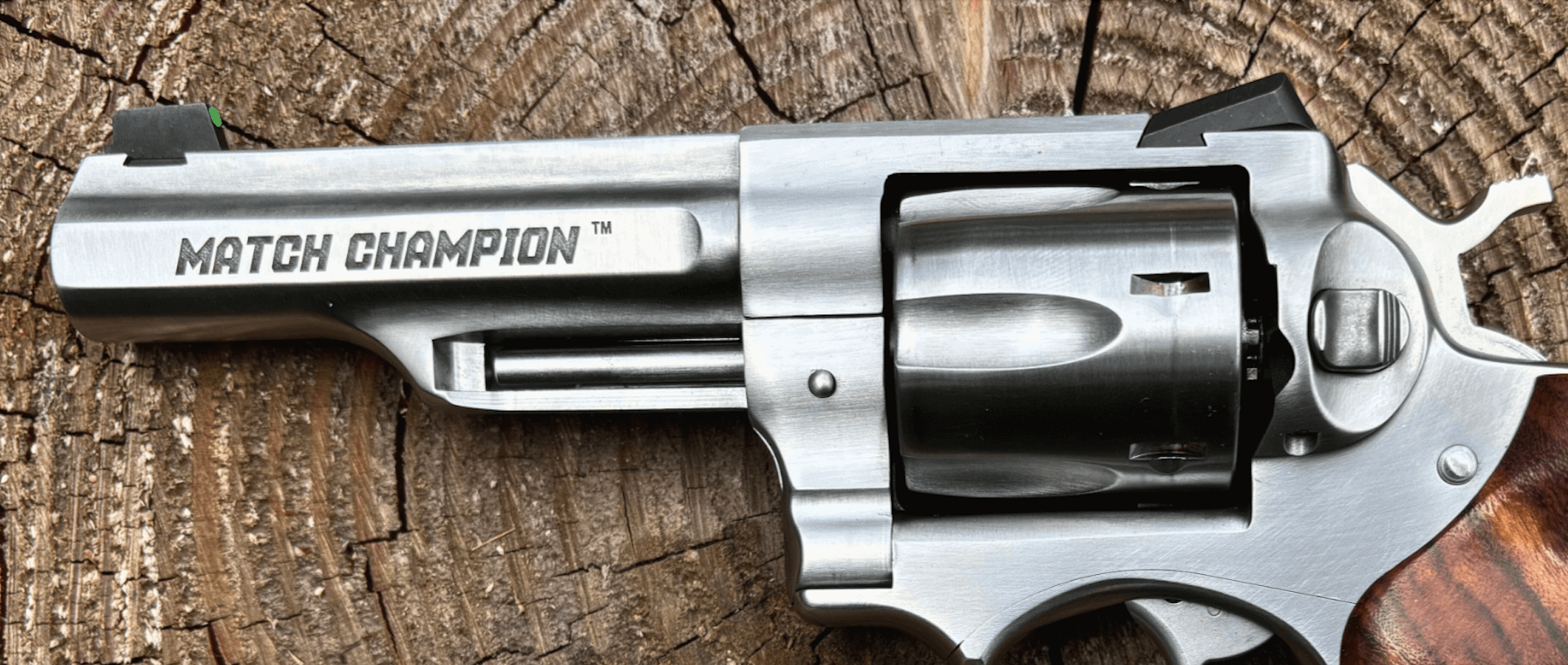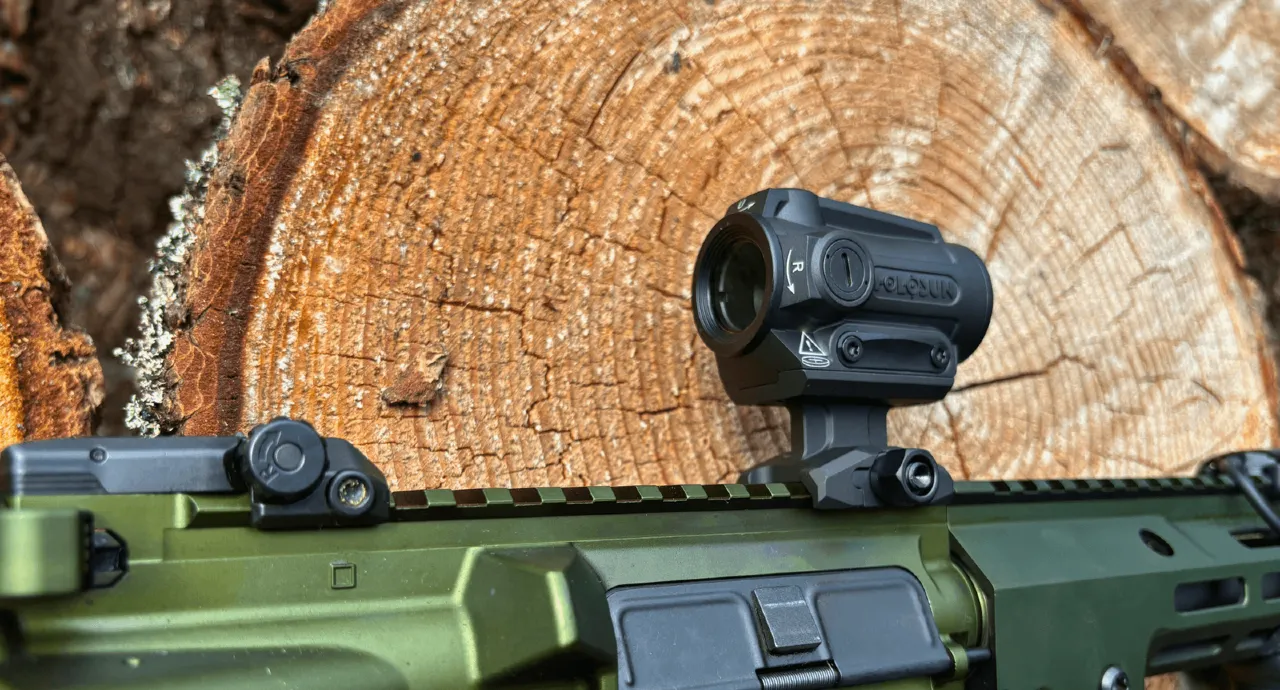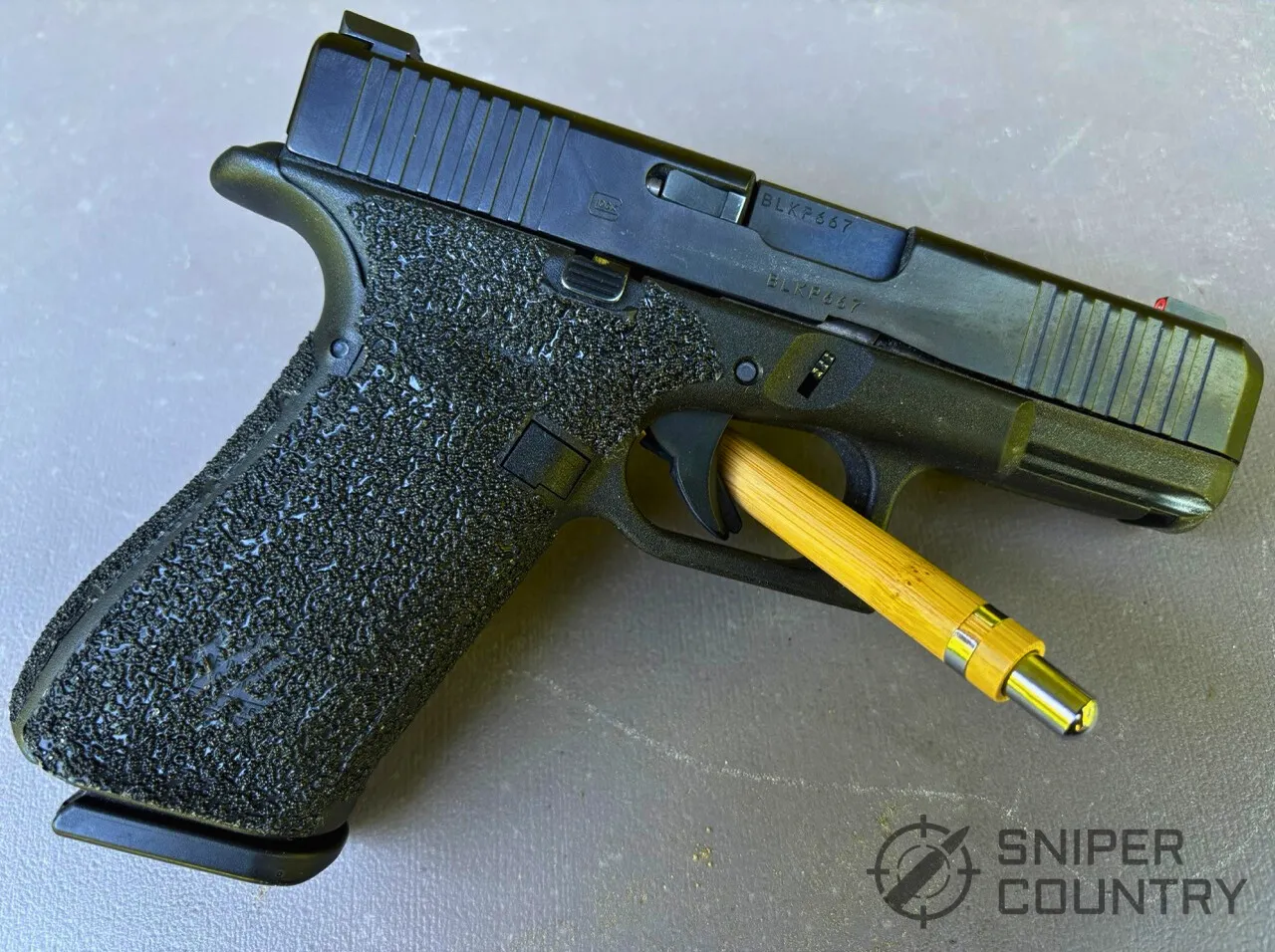Taurus Defender 856 is a J-frame style revolver, which is to say that it has a short frame and a cylinder that holds five rounds of .38 Special ammunition. The J-frame is a common choice for those who like to hide their firearm.
The six-shot 32 is no longer the go-to among shooters, who often prefer the five-shot 38. While five shots are plenty to keep the score close in an offensive match, others would like one additional round. So Taurus developed a revolver with a six-shot capacity slightly bigger than standard J-frame revolvers with five chambers — that’s a lot of pressure for a 38 Special.
In this post, we’ll review the Taurus Defender 856, a six-shot revolver chambered in .38 SPL. Now, let’s begin.
Taurus 856 Defender Pros and Cons
- Excellent Ergonomics: With a three-inch hefty barrel, everything from the grips to the grip angle to the balance is enlarged. The 856 Defender is a breeze to operate, and it’s a pleasure to handle, thanks to these features.
- Tritium Night Sights: It features a front Tritium night sight with orange outline that’s useful for home defense.
- Various Finishes: This revolver offers plenty of finish options like Cerakoted and anodized black versions.
- Versatile Option: You can use this revolver for concealed carry, home defense, and outdoor purposes, and it’s affordable, making it a fantastic all-around pick.
- Cylinder issues: The cylinder occasionally appears to become jammed. You can fix this by replacing, cleaning, and lubricating the cylinder lock spring.
The Taurus Model 85
The model 85 dates back to around 1984. That gun, and the model 66 .357 revolver, have been Taurus’ bread and butter revolvers for many years.
Taurus was once owned by Bangor Punta, who also owned Smith and Wesson simultaneously. Some shooters have commented to me how much Taurus revolvers look like S&W’s, which is because a lot of them were made legally on the same or similar machinery from similar blueprints.
I researched and chronicled a fairly detailed history of the Taurus company when I wrote my review of the Taurus Spectrum .380. The model 85 revolvers are very popular.
Mine’s the Model 85 Ultralite .38 Special +P model with an alloy frame. It weighs about 17 ounces empty and fits in a pocket. It is a 5-shot revolver, somewhat similar to an S&W J-frame. It uses a transfer bar for safety and has the ubiquitous Taurus safety key lock. Also, it has a feature that I like — an extra spring-loaded locking stud on the yoke.
The Six-Shooter Revolver
A five-shot snubbie in.38 Special is the standard, at least in the mainstream. Smith and Wesson legitimized the concept in 1950 by introducing the 5-shot Model 36, the Chief’s Special. This gun was made with a 2-inch barrel, and 3-inchers were available as well.
Colt, early on, decided that six shots were desirable in their snubbies, the same as in their larger guns. So it was only a matter of time before Taurus brought out a snub-nosed .38 with a six-shot cylinder. It happened in 2019 when the company introduced a new line — the 856.
The model designation came from the old “85 model” plus a “6” for six shots. This was a 2-inch-barreled gun that was identical to the 85 — except that it had a six-shot cylinder. Growing in width only a few hundredths of an inch, the new 856 became popular and today sells very well. So why not have an extra round if it only adds a tiny girth to the cylinder?
The same holsters (well, most of them) for the 85 fit the 2-inch 856. Taurus made the 85 in many different finishes and colors at one time but sadly is no more. Now, there are no 85s on the Taurus website. The only .38 snubbie they show is the 856. This is, of course, no big deal and only makes sense from a marketing standpoint.
If you want the 5-shot gun, you can still find them for sale at the usual locations, but if I were buying one today, I’d go with the 6-shooter 856.
The Taurus Defender 856 Revolver
It does — it’s called the Defender 856. Sporting a three-inch barrel. This gun comes in six different variations at the time of this writing, with stainless steel, black (anodized and matte) and tungsten cerakote finishes available.
Grip materials include hard rubber, rosewood and VZ. One constant across the line is the night sight with bright orange insert. The Defender 856 mounts an AmeriGlo H3FJ sight on the barrel.
I cannot begin to tell you how glad I was when I first read that this revolver was going to sport, from the factory, a useful and highly visible front sight. With most snubby sights consisting of the typical trough/ notch in the top of the frame coupled with an almost-visible tiny front post, it was with a great sigh of relief that I opened the box and saw that big, glowing orange dot up front on the replaceable post with a wide notch in the rear.


I have tried almost every bright shade of nail polish and enamel paint on the black front posts of many revolvers over the years as my sight ages along with the rest of me.
Once, I could get by with a black front post, but not anymore. I really appreciated the red inserts that came on various Smith and Wessons that I’ve owned as they helped. So, it is with great fanfare that I announce the brand of nail polish that I’m using now — it’s Pure Ice orangey-pink. There is no color designation, so I went with the scientific name. Also, that shade stands out in a sight picture.
However, the Defender 856 doesn’t need it, it’s already orange to draw your eye and then glows in the dark using the tritium insert. This, to my almost-70-year-old eyes, is the best of both worlds. I had no trouble seeing the sight when I was shooting the gun.
Before we get too involved with details of the Defender, let’s look at some basic specs from both the Taurus web site and my observations.
| Capacity: | 6 rds |
| Action Type: | DA/SA |
| Caliber: | 38 Special +P |
| Height: | 4.80" |
| Width: | 1.41" |
| Weight: | 35.00 oz. (two of the six models use an alloy frame and have a 16 oz. weight) |
| Barrel Length: | 3.00" |
| Overall Length: | 7.50" |
| Trigger Pulls: | SA: 5 lbs. 3.5 oz; DA: 8 lbs, 9.5 oz, measured |
| Front Sight: | AmeriGlo H3FJ Night Sight W Orange Outline |
| Rear Sight: | Fixed |
| Safety: | Transfer Bar, Keyed Lock |
Real-world pricing is a bit hard to find now, as these guns are very popular and have just started to ship. So, keep checking with your favorite gun retailer.
After digesting the specs again (especially the 2-pound-plus weight), I;m beginning to see this revolver in the same size and weight class as the newly-released Colt King Cobra.
Granted, that gun is a 357 Magnum, but the Defender’s height and length are in the ballpark, so invite comparisons. The steel-framed Defender outweighs the Cobra by 12 ounces (23 vs. 35). Don’t misunderstand — I’m not saying that the Taurus is going to take sales away from Colt, but I’m merely stating that this gun frame size/ barrel length seems to be popular right now again.
After shooting the Defender, it’s no wonder that the three-inchers are so hot now.
Taurus 856 Defender Barrel
The three-inch barrel has long been a popular choice for revolver fans. Starting back in the old west (or even before), some shopkeepers and lawmen had their Peacemaker’s long barrel shortened to three or so inches in order to conceal it more easily. Colt even made what became known at the Sheriff’s Model, with a three-inch barrel.
Right up to modern times, the three-incher is a viable choice for concealed carriers who think that a four-inch barrel is a bit too long but want more than a two-inch tube. Smith and Wesson, for one, has made many regular production and Performance Center guns with that length barrel, mostly in .357 and other calibers. They handle very well and are better balanced in your hand than they have a right to be. To my mind, they’re the best of both worlds.
Another small advantage of that extra inch is velocity. But owning a chronograph has done a couple of things for me. It has shown me that a longer barrel makes a difference with velocities and that a longer barrel doesn’t make a difference. Huh? How can it be both of those things? I am continually surprised by what my chrono’s screen tells me.
Short-Barreled Guns and Velocity
For some loads in short-barreled guns, velocities are amazingly high, while other short tube loads register lower-than-expected readings. Nothing can be taken for granted as far as barrel length and velocities are involved.
Generally speaking, longer tubes equal higher velocities, but nowadays, with loads formulated for shorter barrels, you never know what velocities you’ll get until you shoot it over your chronograph. Don’t just assume — measure your velocities.
Speaking of velocities, here is what I found shooting just a couple of loads through two guns. The first gun is the Defender 856 and the second is my 2-inch-barreled model 85.
| Load: | Defender 856 3 inch | 85 2 inch |
| Hornady Critical Defense 110-grain | 875 fps, 187 ft./lbs | 800 fps, 156 ft./lbs |
| Handload, 160-gr cast SWC/3.5 gr. Tite Group | 761 fps, 141 ft./lbs | 735 fps, 189 ft./lbs |
(Energy provided for comparison. Don’t count just on bullet energy when you decide on what load to carry).
I wish I had more .38 ammo on hand, but my supply is very low and it is harder to restock with all the current events taking place. I had done a big experiment (for me, anyway) with several various .38 handloads to shoot in my 85 but came back to my standard 3.5/ Tite Group load. They’re not exactly +P but at least it won’t bend anything when you shoot it.
It is accurate, for the most part (depending on the gun, of course). Interesting to note that the extra inch mattered more with the faster defense load and its 110-grain bullet than it did with the heavier cast bullet load.
I do believe that some folks who are planning on carrying a revolver for self-defense may well opt to carry a 3-inch version with its longer sight radius and a slight gain in ballistics, but there is nothing wrong with the old standby 2-inch version — you don’t give up all that much.
Shooting the Taurus 856 Defender
Speaking of shooting, here are a couple of targets I recorded. Nothing very special here, but at least we know that both loads are at least in the ballpark in terms of printing close to point of aim. I shot these at 10 yards from a rest, center hold.


It’s interesting to see the difference in impact. The Critical Defense hit lower on the target, which stands to reason since a lighter bullet moving faster exits the barrel more quickly than a heavier one moving more slowly since the barrel has less time to rise in recoil.
Both loads hit to the right, but that’s me. You could pick up this same gun and print a group dead center. I must look at the sights sideways, I guess. Both loads were accurate for the type of gun. It shows solid close-range accuracy for the task at hand.
In shooting both guns and describing felt recoil, the heavier 856 wins every time in terms of less felt recoil. Again, that stands to reason since you’re comparing a 35-ounce gun to a 17-ouncer. Even so, neither gun was overly brisk when shot.
The rubber grips on the 85 soaked up the recoil more than did the very nice VZ grips on the 856 — no surprise here. But, the VZ grips held the gun against recoil in my hand every bit as well as did the rubber grips on the other gun.
The front sight was a blessing on the 856, for sure. It would definitely be of value in a low-light situation. I wish I had more ammo on hand, but as I always say when I review a gun — it’s a gun review, not an ammo review.
Taurus 856 Defender Accuracy
As for accuracy, shooting off-hand at 15 yards in a two-inch five-shot group is typical. Shooting in a straight line accomplishes more, and the Defender 856 is a shooter in a straight line.
This revolver has shown to be dependable and simple to use. With the quality of firearms today, I have run across precious few guns of any type that weren’t accurate with at least one type of ammo. So I don’t worry so much about not shooting 15 different loads in my trials, especially when certain types of ammo are still somewhat hard to get. This gun will do just fine in the accuracy department.
Guns like the Taurus 856 Defender are small enough, strong enough, and accurate enough to go along on a hike or camping trip. This is a great option for campers who want to carry little more than a small item on their hips.
Taurus 856 Defender Photo Gallery
Let’s look at a few photos I shot of the Taurus 856 Defender.

Don’t try to use the speedloader you bought for your J-frame or model 85 with the 856/ That extra hole messes things up where that’s concerned. This is obvious, but it just made a fun photo.




It’s not new, as this is a feature that used to be found only on more powerful revolvers. Taurus is including it with its small-frame guns now. It is also present on my model 85. This is a good thing. It’s not a deal breaker if the gun is without it, but it adds a small extra layer of strength to the cylinder.

Note the green tag on the trigger guard — this gun had been displayed at SHOT Show 2020.

The gun is very well-balanced and sits tightly in your hand. The grips are, in a word, excellent. VZ makes some great grips, and these are no exception. I like the gun’s two-tone aspect — the black front sight, hammer, trigger, and cylinder stand out against the stainless frame and barrel.
S&W does this treatment on their model 66 and 69 revolvers (except for the cylinder which is stainless). It produces a handsome revolver.
Carrying the Taurus 856 Defender
Some folks have a little trouble carrying a revolver with a long 3-inch barrel, when they are used to the 2-inch variety. The extra inch really only means that you might have to carry it in an IWB holster as opposed to a pocket holster, which is certainly no big deal.
Some have no trouble carrying a 4-inch or longer barreled semi-auto but balk at a 3 or 4 inch revolver. What you need to remember is that the barrel, usually, is not the part of the gun that dictates whether you carry it or not. Instead, the grip is the part that will print if it is too large.
The barrel is stuck down your pants, to be blunt, where it’s hidden. So, a three or even 4-inch revolver may be carryable with the proper holster.
Add in the bright front sight and the extra inch of sight radius and we have a winner. Rated for +P ammo, the Defender could nip on the heels of a similar barrel length .357 Magnum snubby.
Granted, the magnum round will produce more velocity, but its blast and recoil can be fierce. For a really good video that compares the ballistics of those two calibers in a snub-nosed revolver, check this out:
You should have a good experience if you decide to carry this gun. It seems very business-like but still is a good-looking revolver. Accurate and reliable — it should do the job. And, if you carry a speedloader or speed strips, your reload times should improve steadily — just practice reloading a lot with dummy rounds.
Taurus 856 Defender Takedown
To show how to field strip and maintain the 856 Defender, here’s a video I found to show you how.
Final Verdict: Is the Taurus 856 Defender a Good Gun?
Hopefully, you might start to see carry revolvers in a new light, if you’re not there yet. One can find several different three-inch-barreled wheelguns on the market, but this one is bound to make its presence known in a big way.
If you are curious, get to your Taurus dealer and ask him or her to try to get one in for you to look at. I was glad to get one. It took a long time after my initial request for it to get here but the wait was worth it. Getting one that had been displayed at the SHOT Show was just icing on the proverbial cake.
If you want a lighter-weight gun, there are two alloy-framed models. Want all-black? No problem. Rosewood grips? Gotcha covered. Another good choice on Taurus’ part was that all models have the AmeriGlo night sight. Good on you, Taurus.
Taurus cut its teeth by making revolvers — their first one was made in 1941 — and they seem to have it figured out. Couple that with the new direction in which the company has pledged to go (I received a lengthy email from their CEO, as did many of you I’m sure) in regards to customer service and increased availability of parts on their web site and you hopefully have a recipe for success.
With current-production .38 SPL defense ammo, the updated, modern “old 38” is a viable candidate for concealed carry and this revolver is one classy way to carry it.
As always, leave a comment below if you like and be safe.













10 Responses
Mike, thank you for the review of the Taurus Defender. These models have not yet made their way to retailers. The pandemic has had a pejorative impact, forcing Taurus to charter planes to the US from Brazil with their products. Although several .22 handguns are being made in the new Georgia US facility, the majority are still imported from South America. As to the revolver you reviewed, the 35 ounce iteration of the Defender is the same weight and size as the Taurus 692 with a 3″ ported barrel. The 692 chambers 7 rounds of either .38 Special, .357 Magnum, or 9mm (with a quick change of the cylinder). If one were to be offered a choice of the 6 round Defender (.38 Special +P) or the 692, the latter would clearly be the better option, except for one critical difference: price. There is in excess of a $200 difference in the MSRP of the weapon you reviewed, and the stainless 3″ 692 (which oddly retails for $692). If one is a wheel-gun fan, and can afford the upgrade, the 692 is the better option simply based on more variety of ammo options (as well as the ported barrel, which really helps control muzzle rise with .357 magnum ammunition). But the Defender (especially the less weighty options that come in around 16 ounces) would be a solid choice for the range as well as self-defense. I was initially interested in the tungsten Cerakote model with the wooden Altamont grips. However, I’m now leaning toward the lighter model and ordering the laminate grips from Altamont to install myself. At any rate, Taurus obviously understood that abandoning the 3″ barrel option in their revolver line some time ago allowed S&W, Ruger, and Charter Arms to fill the void with product, to the exclusion of the line from Brazil. Good to see them back in the game in this barrel length, as well as Mr. Voorhees’ promise to address the customer service issues with which they have long been troubled.
John, it’s good to see a reply that not only mentions the reviewed gun but also includes an alternative. Taurus has made more than one double-action revolver with an extra cylinder (from .38/.357 to 9mm), which takes some engineering. I have a Ruger Blackhawk in .45 Colt that has a .45ACP cylinder, but that’s a single action gun. Even some of the inexpensive Heritage .22s come with a .22 Mag cylinder, but Taurus has really given the shooter some options with their interchangeable DA guns. Thanks for your insight as to why they’re in short supply, and thanks for writing!
You have my interest peaked on this one.
Bert, let us know if you end up with one – thanks for writing!
Hi Mike,
I have an 85 and 856 (both in 2″). Like them both. The 85 fits most J-frame holsters. The 856 does not. In fact, I haven’t found one decent holster for the 856. Do you have a list of holsters that do fit the 856? Thanks.
Matt, a quick Google search found Crossbreed Holsters – they make some for the 856. Also, the inexpensive nylon holsters that come with a strap – you probably know what I’m talking about – that have an open bottom will accomodate the 856. I found some of those on Amazon. It is this type that I had in mind when I said that most 85 holsters will fit the 856 – the nylon ones expand easily and, with the open bottom, will carry a three-incher. Check Crossbreed for more options – they start at about $40, and have a kydex shell backed by your choice of leather. Hope this helps – thanks for writing!
The weight you have listed on the steel version is way off. The steel 2 inch 856 is only 22 ozs , lotta extra weight for an extra inch of barrel,lol. web site says 35 ozs also. Great review thanks. Bought my wife and daughter both 85 ul models,they love them. Time to get dad the 3 inch version. thanks again
Lou, that’s what I get for quoting manufacturer specs – I need to invest in a digital scale, huh? Anyway, 22 ounces isn’t that much and would allow concealed carry fairly easily. Thanks for correcting me – I want to make sure my facts are right. Thanks for writing!
Did Taurus enlarging the Model 85’s cylinder just enough to make Model 856 a 6-shooter result in the 856 being less strong than the 85?
I presume the cylinder walls between the 6 charge holes of the Model 856 are necessarily thinner than those of the 5-shot Model 85.
Michael, I don’t think the 856 is any less strong than the 85. The cylinder diameter was increased just a bit, but enough to create enough wall strength to handle +P ammo – all 856 models on the Taurus website show +P capability. If the 856 cylinder was not up to the task of shooting +P, they wouldn’t advertise it. So, yes, I think the 856 is OK in the cylinder strength department. Thanks for writing – you made me do some research and that’s a good thing!